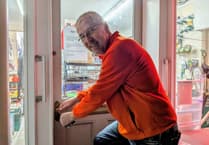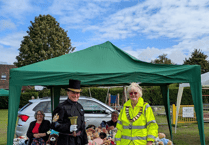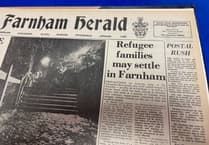Kings Pond is a subject that cuts across the scientific disciplines and time, involving geology, hydrology, climatology, meteorology, human history and land use, and the natural history of the plants and animals that frequent the site – including us.
They are linked in ecological processes – plant succession, food chains, predation, carrying capacity and population dynamics – so management of the pond requires a good grounding in all of these subjects, as well as study of parallel case histories.
The weather extremes of future climate change also need to be accommodated.
The human species is probably the most damaging element and there are more and more of us.
The population of Alton has risen from about 2,000 at the beginning of the 19th century, to around 5,000 at the beginning of the 20th century, to around 8,000 by 1970 and currently around 20,000.
It is only in the past 50 years that the pond has been open to the public and it will face more people pressure with the present wave of large-scale developments.
Rivers are linear features connected both up and down stream and to the land alongside, with actions having many side-effects.
This is acknowledged by the Environment Agency, which under government instructions set up a catchment-based approach to bring our rivers to good ecological status.
The northern River Wey is part of the Wey Valley Landscape Partnership hosted by the Surrey Wildlife Trust, which is the catchment-based group for the Wey.
The natural world gives limiting factors that we need to know about, comprehend and respect. Some things we can change, others not.
When all influencing factors are considered as a whole, the solution for the management of Kings Pond is not as simple as some people suggest.
It is composed of many influencing strands that are all inter-connected, so a multi-disciplinary approach is needed based on good factual data, rather than the narrow single-issue emotional approach adopted by many public commentators.
The next stage is an assemblage of such data, understanding the geology and hydrology which enables the pond and river to exist above ground.
The river is sourced from ground water out of chalk springs that issue from Will Hall Farm and all along its passage though Alton and Holybourne.
It is also part of the floodplain of the Wey. Some knowledge of the past history is important. Kings Pond is not a natural feature, it was created by damming the River Wey to create a reservoir of water to power an 18th-century paper mill that increased in size.
It is an on-line pond with the River Wey flowing through, and suspended silt drops in still water. By the time of the tithe map of 1842 the pond had reached its current size, but there was no large island.
The paper mill worked until 1908, and for a short time in the 1920s the Alton Battery Company used the water wheel to generate electricity before mains electricity came to Alton. Silt was usually passed downstream when the mill was running.
In the late 1960s and early 1970s Alton Urban District Council acquired the current site in various purchases which included the pond.
It was dredged in 1973 and a circular path made around it to prepare it as a public green space for quiet recreation. It is, however, a small site.
Redundant industrial sites, which Kings Pond is, are frequently re-used for public amenity land. A number of lakes, such as Dinton Pastures in Reading, were created in old gravel pits. At that site, the River Loddon flows alongside the gravel pit lakes. We can learn from these other examples.
Kings Pond is not in good health. Part of it is silting up, it is lacking water weeds and the water quality is poor through high nutrient content.
This is evidenced from the vigorous growth of green filamentous algae and aquatic mosses in the outlet channels in Waterside Court that receive pond water exiting from the weir.
In contrast, by the footpath from pond to Waterside Court is a channel of culverted spring water that is clear and the bottom gravel not colonised by algae.
Since the late 1980s, Canada geese have established at Kings Pond and by the late 1990s had built up in considerable numbers, with 11 nests established on the large island.
They are large birds with large appetites that normally eat grass and produce copious droppings. Canada geese are present most months of the year, only moving off-site in November but returning in January.
The large population is driven by uncontrolled public feeding that changes bird behaviour towards dependency on humans, which unfortunately charms the public and so the practice continues and goose numbers build up. This link needs acknowledging.
Firstly, we need to assemble technical data on water chemistry of nutrients and heavy metals, turbidity and oxygen level at various times of year and both above and below the pond in the River Wey. This involves working with others.
The silt comes from different sources, some from road drains and unofficial surface run-off and, on occasion, from arable land above Brick Kiln Lane when the river and pond go brown.
Another source of silt is from the break-up of the large island, which is happening again now as it did in 1995. Balancing ponds not connected with the river are a common modern solution to silt and pollution.
We need to keep an open mind on taking the pond off-line and be guided by previous examples elsewhere, such as Letcombe Regis Brook in Oxfordshire.
Oiling of the eggs of Canada geese needs to continue, as it does reduce the recruitment but does not reduce the numbers, as geese are long-lived birds. The method was obtained from the RSPCA Wildlife Department and the Wildfowl and Wetlands Trust.
It is commendable how most dog walkers now pick up their dogs' faeces, so human behaviour can change and needs to change regarding feeding of the birds.
Humans like to control and tame animals, and some enjoy a dependency culture which erodes into the sturdy independence of populations of wild animals that is traditionally their life-support system.
Enjoy watching birds – it is beneficial for all ages – but let them lead their natural lives and do not treat them as toys.
Dr June Chatfield OBE





Comments
This article has no comments yet. Be the first to leave a comment.